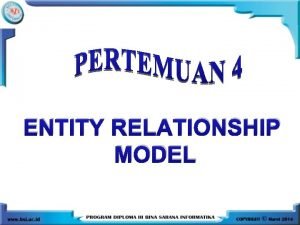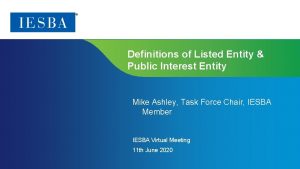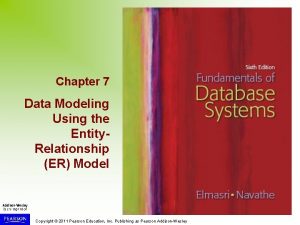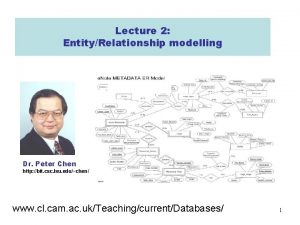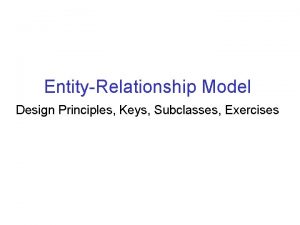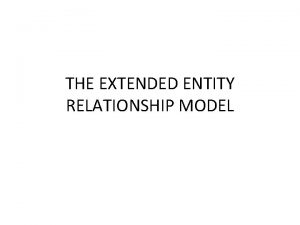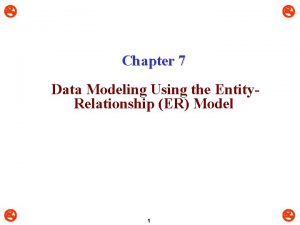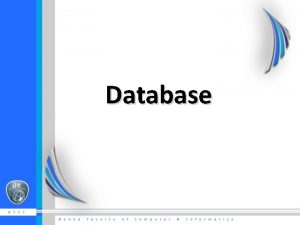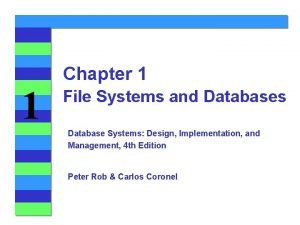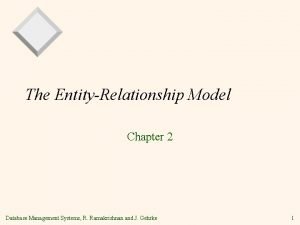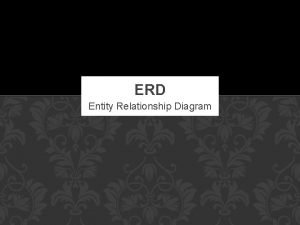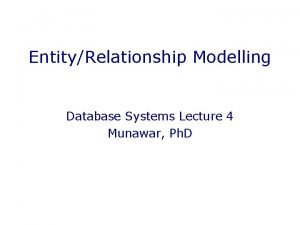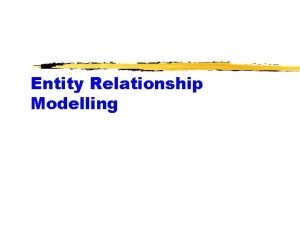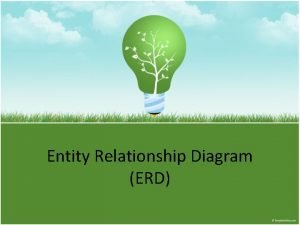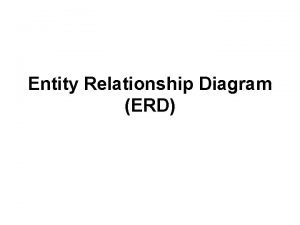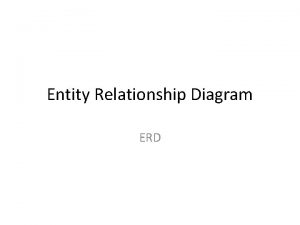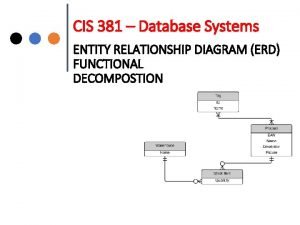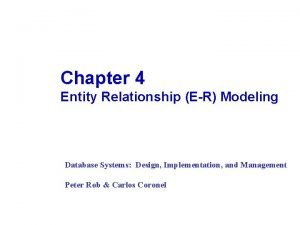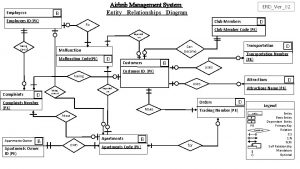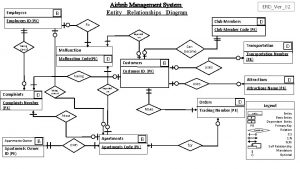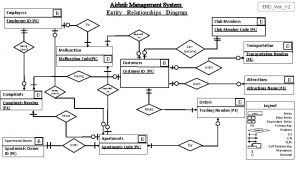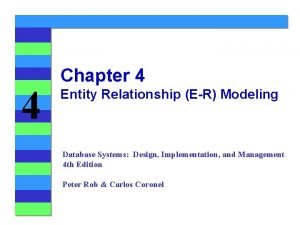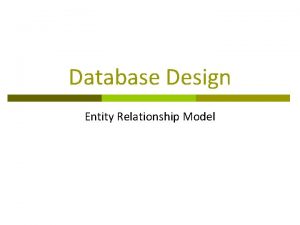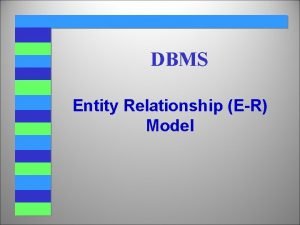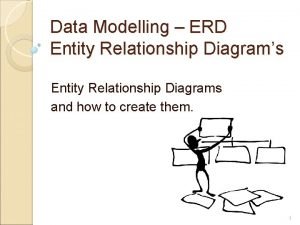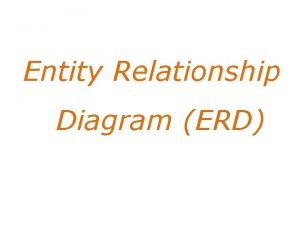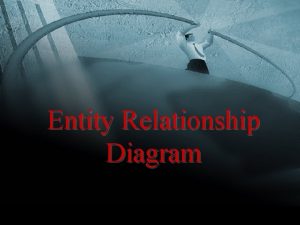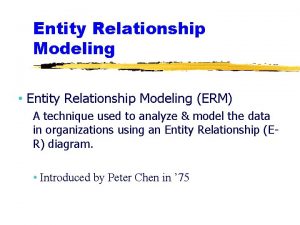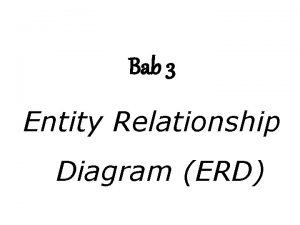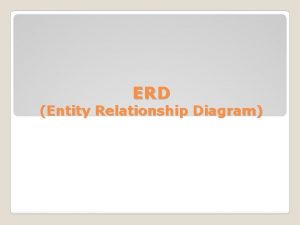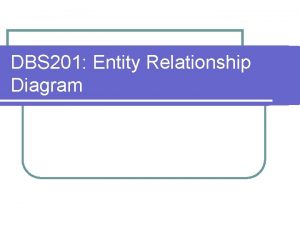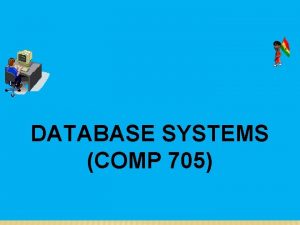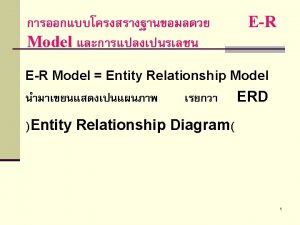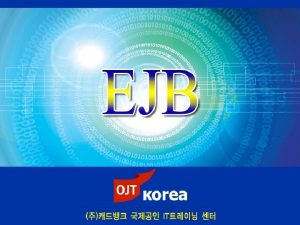Entity Relationship Model ER Model Entity Relationship Model






























- Slides: 30

Entity – Relationship Model (E-R Model)

Entity – Relationship Model • The overall logical structure of a database can be expressed graphically using E-R diagrams. • Features of E-R Model – This is used to give structure to the data. – Model can be evolved independent of any DBMS – It is an aid for database design. – It is easy to visualize and understand.

Basic Concepts • Entity set • Attributes • Relational sets • Entity set – An entity is a ‘thing’ or an ‘object’ in a real world. – Example • Person, car, house, book, publisher etc. . ,

• Attributes – The properties that describe an entity are called attributes. – Example • Customer (entity) • Customer_id, Customer_name, city are called attributes. – An attribute can be classified into various type • • • Simple Attributes Composite attributes Single valued attributes Multi valued attributes Derived attribute

• Simple attributes – An attribute that cannot be divided into further subparts – Example • Roll_no, Acc_no • Composite attributes – An attribute that can be divided into a set of subparts. – Example • Customer_name divided – Firstname , Middlename, Lastname • Address – Street, City, Pincode

• Single valued Attribute – An attribute having only one value in a particular entity – Example • In a customer entity, – Name, id, street are single valued attribute • Multi valued attribute – An attribute having more than one value for a particular entity – Example • Customer (entity) – (attribute) phone no • Student (entity) - (attribute) hobby (reading, music, painting etc. , ) • Derived attribute – An attribute that is derived from other related attributes or entities – Example • Age of a customer entity set is derived from the attribute date_of _birth of a customer.

• Relationship set – Relationship is an association among several entities. – Example • Person and company relationship

Types of Relationships • Unary relationship – An unary relationship exists when an association is maintained within a single entity. – Example • Boss and worker are two employees • Manage is association

• Binary relationship – A binary relationship exists when two entities are associated.

• Ternary relationship – A binary relationship exists when three entities are associated. – Example

• Quaternary relationship – A quaternary relationship exists when there are four entities associated. – Example

Constraints • Two main important types of constraints are: – Mapping cardinalities – Participation constraints

Mapping Cardinalities • Mapping cardinalities or cardinality ratio express the number of entities to which another entity can be associated via relationship set. • Types are – One to one – One to many – Many to one – Many to many

One to one • An entity in A is associated with at most one entity in B. • An entity in B is associated with at most one entity in A

One to Many • An entity in A is associated with any number of (0 or more) entities in B. • An entity in B is associated with at most one entity in A

Many to one • An entity in A is associated with at most one entity in B. • An entity in B is associated with Zero or more number of entities in A.

Many to Many • An entity in A is associated with any number (0 or more) of entities in B and vice versa.

Participation Constraints • Total participation – The participation of an entity set E in a relationship set R is said to be total if every entity in E participates in at least one relationship in R. – Example • Salary relationship employees • Partial participation – If only some entities in E participate in relationships in R • Employees relationship commission

Keys • A key allows to identify a set of attributes or relationship. • Different types of keys are – Super key – Candidate key – Primary key – Foreign key

• Super key – A super key is a set of one or more attributes that allows us to identify uniquely an entity in the entity set, – Example • Roll_no attribute of the entity set ‘student’. • Candidate key – A candidate key is a minimal super key for which no proper subsets can be formed. – Example • {studnt_name, student_class} • Primary key – Primary key is a key that has unique value – Example • Employee (eno, ename, salary, job, dno), eno is the primary key • Foreign key – An attribute in one relation whose value matches the primary key in some other relation is called a foreign key. – Example • Employee (eno, ename, salary, job, dno) • Dept (dno, dname, dloc) Dno is primary key and eno is primary key So dno is foreign key

• Weak Entity set – An entity set may not have sufficient attributes to from a primary key. Such an entity set is termed as weak entity set. – Example • Payment entity set with the attributes of payment_type, payment_amount and payment_date. • Strong Entity set – An entity set that has a primary key is termed as a strong entity set. – Example • Loan entity set with the attributes of loan_id, loan_amount, loan_type

E-R diagram symbols

Alternative E-R Notations

E-R Diagram with relationships

E-R Diagram with relationships cont…


Construct an E-R diagram for a car insurance company whose customers own one or more cars each. Each car has associated with it zero to any number of recorded accidents.

Construct an E-R diagram for a hospital with a set of patients and a set of medical doctors. Associate with each patient a log of various tests and examinations conducted.

Construct an E-R diagram to model an online book store.

Construct an E-R diagram for a banking system
 Total participation adalah
Total participation adalah Contoh weak entity
Contoh weak entity Public interest entity vs listed entity
Public interest entity vs listed entity Public interest entity
Public interest entity Modified chen notation
Modified chen notation Data modeling using entity relationship model
Data modeling using entity relationship model Peter chen 1976
Peter chen 1976 Entity relationship model exercises
Entity relationship model exercises Extended entity relationship model
Extended entity relationship model Entity-relationship model
Entity-relationship model Erd identifying relationship
Erd identifying relationship Entity-relationship data model
Entity-relationship data model Entity relationship data model
Entity relationship data model Entity relationship data model
Entity relationship data model Eer vs erd
Eer vs erd Entity vs relationship
Entity vs relationship Sebutkan kategori dalam membuat eer
Sebutkan kategori dalam membuat eer Relasi ganda adalah
Relasi ganda adalah Erd digunakan untuk
Erd digunakan untuk Student course entity relationship diagram
Student course entity relationship diagram Erm diagram
Erm diagram Elements of entity relationship diagram
Elements of entity relationship diagram Simbol-simbol erd
Simbol-simbol erd Attributes of relationship in er diagram
Attributes of relationship in er diagram Peter chen erd
Peter chen erd Erd business rules
Erd business rules Connectivity in er diagram
Connectivity in er diagram Airbnb entity relationship diagram
Airbnb entity relationship diagram Airbnb entity relationship diagram
Airbnb entity relationship diagram Airbnb class diagram
Airbnb class diagram Tiny college erd
Tiny college erd

